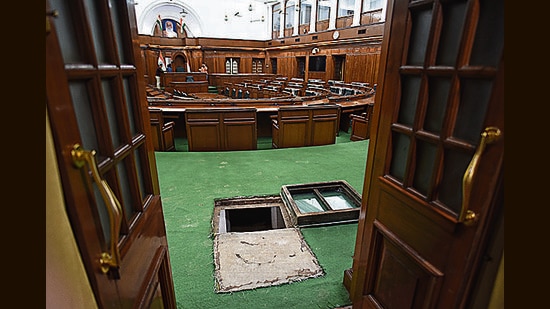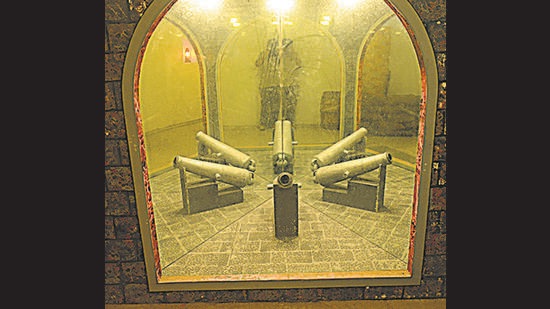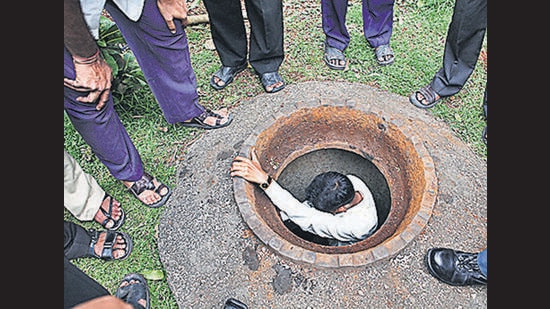If cities were turned upside down, we’d find, more often than not, whole parallel habitations we didn’t recognise — remains of secret getaways, private chambers, hidden passages. Across India, these are generally discovered by accident, since many existed as escapes and were kept secret, or were built at a time before blueprints and then forgotten. They are now rediscovered amid renovations and restoration work, municipal pipe-laying and utility projects or, sometimes, because rumours they’re there become impossible to ignore.
Here’s a look at five recent discoveries.
Tunnel between Red Fort and the Delhi Assembly
A murky, century-old horseshoe-shaped tunnel curves from beneath the white, low-rise Delhi Legislative Assembly building to the one-time administrative heart of Mughal India, the Red Fort. The 6-km tunnel was first disclosed to the public in 2016, but it wasn’t exactly unknown before then. “I heard rumours about it when I first became an MLA in 1993,” Ram Niwas Goel, speaker of the Delhi Legislative Assembly, told Wknd.
The doorway to the tunnel was officially “opened” in September 2021. It stands right across from the Speaker’s chair in the Assembly Hall. The tunnel then branches out in two directions: to the Red Fort, and to the faansi ghar or gallows room.
The faansi ghar leg is currently under renovation and will soon be opened to the public, tentatively on August 15. “The British didn’t leave any records of this tunnel, so we don’t know when it was built,” says Goel. “We have dug through part of it. Over the years, parts have been damaged due to surface activities.”

Goel believes the tunnel could date to 1912, when this building was used as the Central Legislative Assembly. Or it could date to 1926, when the structure was turned into a courthouse. This tunnel may have been used to transport political detainees from the Red Fort, where the British imprisoned freedom fighters and revolutionaries, to the court — and, in a sinister turn, the gallows room too.
Delhi-based historian Swapna Liddle believes the tunnel may have served a more mundane purpose. “Delhi is full of legends of underground passages. Some are genuine tunnels, especially those inside citadels and forts. They would have led to a spot slightly outside the walls of the fort and may have been used as an escape route. But basements for storage and dwelling were common too,” she says.
Perhaps this was built as an escape route for the British, Liddle adds. But it is unlikely that the British would transport prisoners in such a complicated manner, she adds. “Could these be remains of older structures? Unless the bricks are studied, the tunnels examined, no one can say for certain.”
A secret “vault” at the National Library, Kolkata
In 2010, archaeologists discovered a hidden chamber with no visible entrance, within the 250-year-old National Library building in Kolkata. It was discovered during restoration work undertaken by the Archaeological Survey of India. “Only a walled-up arch could be seen from the outside. It was speculated that a tunnel led from this heritage building to Fort William, about 3 km away,” says Sanjay Maiti, assistant library and information officer (preservation).
When no such tunnel was found, there was speculation that it was a secret chamber, a torture chamber; perhaps it was a secret treasure vault put there by the Nawab of Bengal, Mir Jafar, who built the original structure as a mansion named Belvedere Estate, in the late 1700s.
As it turned out, the “mystery room” had a very dull backstory. It was a mud-filled block, possibly added by architects to strengthen the building and its foundation in later years, when one of its extensions was being built.
Beneath the Golden Temple, Amritsar
During excavation operations to build a jora ghar or shoe room adjoining the Golden Temple complex in July, a tunnel-like structure composed of small bricks, supposedly last used centuries ago, was discovered.
It turned out it wasn’t a tunnel but a series of basement dwellings, built in the early 1800s as a gift from Maharaja Ranjit Singh to Giani Sant Singh then head granthi (or ceremonial reader) at the Golden Temple.
The maharaja built the dwellings to thank Giani Sant Singh for his careful supervision of the Golden Temple’s gold plating, a sixth-generation descendant named Yadwinder Singh, 80, told HT in July. “We were one of the four families, all descendants, who lived there until 1988,” Yadwinder Singh added.
There was a kind of tunnel involved too. “My forefathers used an underground path to perform their duties as granthis and give their discourse,” Yadwinder said.
The Shiromani Gurdwara Parbandhak Committee has since invited archaeologists and historians to study the structures and weigh in on the history of the site.
A 13-room bunker under Mumbai’s Raj Bhavan
This isn’t so much a bunker as an alternative HQ. Beneath Mumbai’s Raj Bhavan, the official home of the governor of Maharashtra (and before that of the Bombay Presidency), sits an underground complex of 13 rooms used to store ammunition, and perhaps serve as safe haven.

The rooms were discovered in 2016, by then Maharashtra Governor C Vidyasagar Rao. He had heard from long-time staff and employees that such a tunnel existed, and decided to investigate. The state public works department was called in and took down a wall on the eastern side that had hidden the entrance to this British-era bunker.
Inside was a 20-ft gate and a ramp, with the rooms extending beyond it. Conservation architect Vikas Dilawari, who worked on the restoration of the space, says he believes it was created shortly before World War 1, and extended in parts. “There appears to have originally been a link to the main house too, but we were unable to locate it,” Dilawari adds.
The underground bunker is notable for having a complete drainage system as well as inlets for fresh air. The rooms’ names are telling: Shell Store, Cartridge Store, Workshop. Some rooms extend to directly beneath the governor’s residence and office.
Hiding under the General Post Office, Mumbai
In 2010, an old stone tunnel was uncovered beneath the General Post Office’s front lawn. It is believed to be over 200 years old, which would make it about twice as old as the GPO itself. The metal lid that covered its entrance was assumed to lead to a manhole. When it was eventually opened, a vast stone tunnel was discovered, wide enough to hold several people abreast.
The tunnel is believed to have been built just after Napoleon conquered Egypt in the late-1700s, at a time when the British were concerned he might turn his attention to Bombay. Another theory holds that it was designed alongside the GPO, which was completed in 1913.

Either way, the tunnel seems to have been meant to serve as an escape route. Underground, it branches out in two directions, with wide, thick walls and a muddy floor. One branch ends at the Mumbai docks, the other at the Mint, both less than 1 km away.
Amid the freedom struggle and revolutionary activity, it is believed that the tunnels were built so the British could ferry bullion from the GPO’s treasury to the Mint for safekeeping or in extreme cases to the docks for export to Britain.
About 500 metres from the GPO is St George’s Hospital, where another tunnel runs from beneath the current swine flu ward, in three different directions: to the Gateway of India 2.2 km away, to the port’s Blue Gate across the road, and towards St Thomas Cathedral, about 2.5 km away. All three arms of the tunnel are now obstructed by mud and water, but historians believe these were meant as a military escape route and a means of ferrying and storing arms and ammunition.
Enjoy unlimited digital access with HT Premium
Subscribe Now to continue reading

Stay connected with us on social media platform for instant update click here to join our Twitter, & Facebook
We are now on Telegram. Click here to join our channel (@TechiUpdate) and stay updated with the latest Technology headlines.
For all the latest Art-Culture News Click Here
